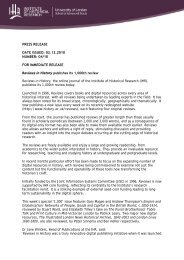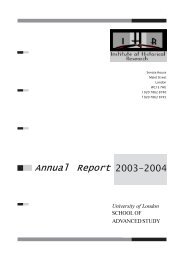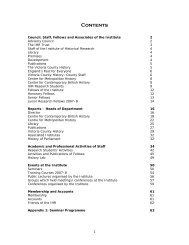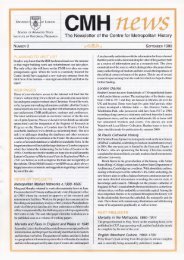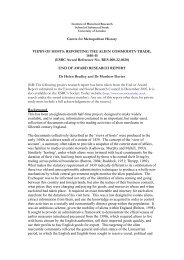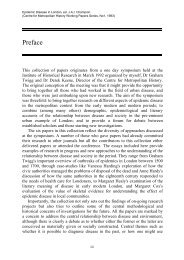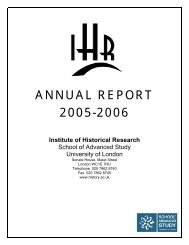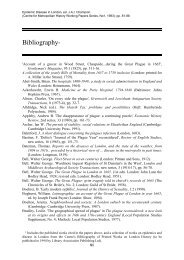CMH AnnuAl RepoRt 1999â2000 - Institute of Historical Research
CMH AnnuAl RepoRt 1999â2000 - Institute of Historical Research
CMH AnnuAl RepoRt 1999â2000 - Institute of Historical Research
You also want an ePaper? Increase the reach of your titles
YUMPU automatically turns print PDFs into web optimized ePapers that Google loves.
Metropolitan Market Networks<br />
Despite London’s great size in the early fourteenth century, its hinterland, as<br />
defined by intensive commercial interaction, appears to have been limited to the<br />
south-east and the Midlands. By 1424 that hinterland took in much <strong>of</strong> England,<br />
at a date significantly earlier than sometimes suggested. Further change by 1570<br />
concerned the structure <strong>of</strong> that hinterland rather than its extent. The principal<br />
shifts evident between 1424 and 1570 include the increasing dependence <strong>of</strong> the<br />
territory immediately around London on the city itself, a decline in the relative<br />
intensity <strong>of</strong> contacts with counties to the south and east <strong>of</strong> London, a corresponding<br />
relative increase in contact with interior counties to the north and west, including<br />
Hertfordshire, Bedfordshire, Wiltshire and Warwickshire, and an increase in the<br />
proportion <strong>of</strong> debts contracted between inhabitants <strong>of</strong> the capital itself. There is<br />
also an increase evident in contacts between London and Yorkshire, Cheshire<br />
and Northumberland, although not apparently with other northern counties,<br />
while a relative decline in contacts with Devon and Cornwall is indicated (see<br />
Fig. 1). These changes, which on the whole contrast with the marked national<br />
shift in population and wealth in favour <strong>of</strong> the south-east between the fourteenth<br />
and sixteenth centuries, suggest that within that region there was a movement<br />
<strong>of</strong> business into London itself while, at least at some levels <strong>of</strong> commerce, more<br />
distant counties were becoming more important for Londoners than those in its<br />
immediate vicinity. In particular, London became a more dominant market for<br />
livestock and coal. In several regions Londoners had come to intervene directly<br />
in the market for local products, rather than operating through provincial centres<br />
and middlemen, as had been the case in 1424. In Exeter and Devon as a whole,<br />
however, the opposite took place. In the south-east, London seems to have become<br />
an increasingly dominant centre for retail trade.<br />
These changes, associated with trade in a wide range <strong>of</strong> commodities including<br />
manufactured goods and raw materials for industry, were not straightforwardly<br />
reflected in measures <strong>of</strong> wheat price integration. Comparison <strong>of</strong> Exeter and<br />
London prices and their relation to fluctuations in the Exeter grain trade<br />
suggest that in the early fourteenth century both places were part <strong>of</strong> a relatively<br />
well-integrated coastal wheat market in which London may not have been<br />
dominant. That market rather may have centred upon Flanders and other parts<br />
<strong>of</strong> the near-Continent as well as embracing coastal districts <strong>of</strong> south-eastern<br />
and south-western England. Decline in aggregate demand for cereals after the<br />
Black Death may have precipitated a decline in the level <strong>of</strong> integration <strong>of</strong> coastal<br />
grain markets. The 1360s seem to have ushered in a period <strong>of</strong> generally greater<br />
price volatility at Exeter, suggestive <strong>of</strong> a less efficient and less well integrated<br />
market. This trend to increasing volatility at Exeter culminated in the 1430s,<br />
after which a notable decline is evident until the last decade <strong>of</strong> the fifteenth



